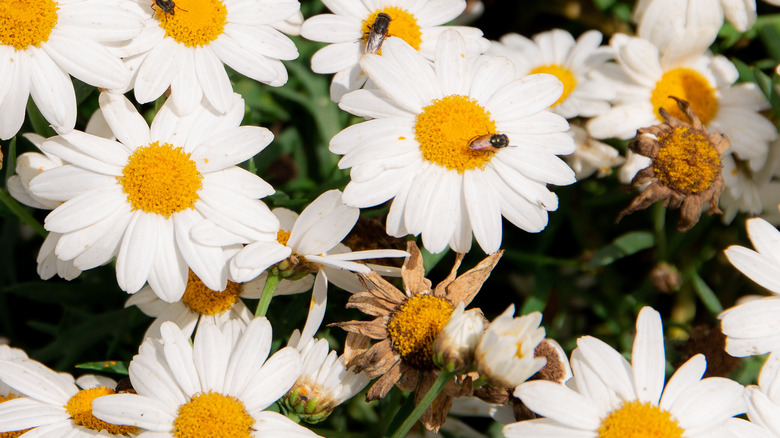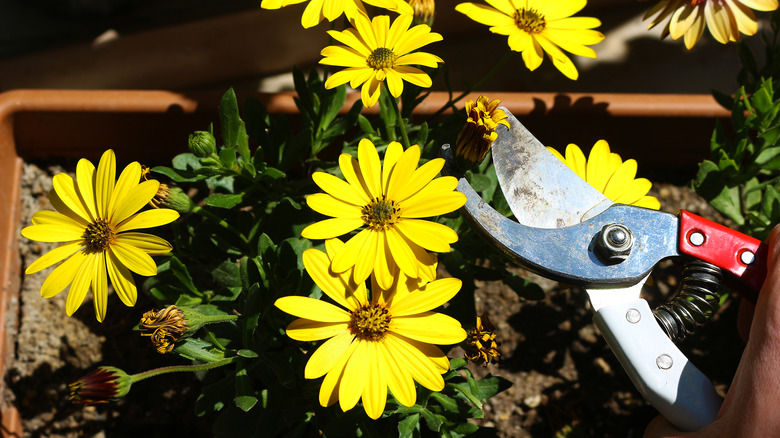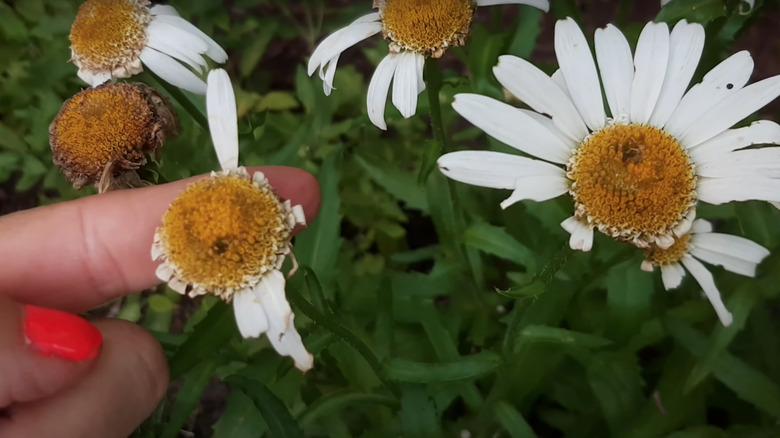How And When To Deadhead Daisies
Daisies are a garden staple, loved for their various colors, bright bulbous centers, and slim elongated petals. With more than 15,000 known species, daisies make a good fit in your garden, whether you prefer container or ground planting or small or large florals. Growing daisies is also relatively easy, even for those who wouldn't say they have a green thumb. Aside from fertilizing and watering, a large part of their care is the deadheading process. Deadheading is the simple removal of wilting flowers on a plant, keeping the amount of self-sowing to a minimum. Allowing a plant to self-sow can lead to unwanted starters in less-than-ideal places. Additionally, removing flowers before they have a chance to rot will lower the risk of pests and diseases.
Naturally, after a flower has bloomed, its life cycle begins to decline, and it will try to scatter its seeds in an attempt at reproduction. We can stop this process with deadheading and allow your current plant to continue thriving and pushing out new and healthy growth. With some gardening shears and gloves, you'll be able to easily and quickly remove fading flowers just above growth points so that energy is focused on that new foliage. You won't want to snip flowers off too early or too late, and instead, keep up with the start of browning petals throughout the entire growing season.
Deadheading daisies
As you begin the process of deadheading your daisies, you'll want to have sharp and sanitized gardening shears and protective gloves. The gloves won't just protect you from the risk of cutting yourself but also from being exposed to sesquiterpene lactone, a chemical compound found in the Asteraceae plant family and known to cause skin inflammation, per Gardener's Path. And clean tools will prevent any pathogens from spreading in your garden. As you prune off dying daisies, you should remove more than just the flower bud, or you could end up with a plant that's trying to support headless stems. You'll want to follow the length of the dying daisy down to the lateral bud and snip the stem about a ¼ inch above the new growth point.
A lateral bud is found sprouting between the mature leaves and the stem and is the life support of a new bud. So, it's essential to be sure you are not severing new life and only clipping away the old. If your daisy shrub is made up of many smaller florals on one branch, it is safe to remove the entire shoot a ¼ inch above the base of the oldest, fading flower. Once you've collected your deadheads, place them in a compost bin rather than tossing them out and letting nothing go to waste.
Following the right schedule
Understanding the perfect timing in deadheading your daisies is crucial to the plant's overall health. If you are clipping off flowers prematurely, it could result in a lapse of new growth. However, if you are deadheading too late, then you'll likely still experience self-germination and less energy in producing fresh florals and strong roots. Daisies begin blooming in spring and are in full swing by the time summer approaches, their prime growing season lasting until the start of autumn. Throughout these months, you'll want to be checking on your daisies regularly for any needed pruning. A daisy's life cycle is typically seven to 10 days, so that is approximately how often you can expect to be deadheading.
As soon as you detect a flower starting to deteriorate, you should go ahead and remove it before seed pods begin to spur. If you want your daisies to do some self-sowing, you can be much more relaxed in how often you trim them. You can also cut back on deadheading as fall approaches and the thick of the growing season passes. As the perennials die back for the winter, birds will visit your garden and snack on the seeds from your wilting daisies.


